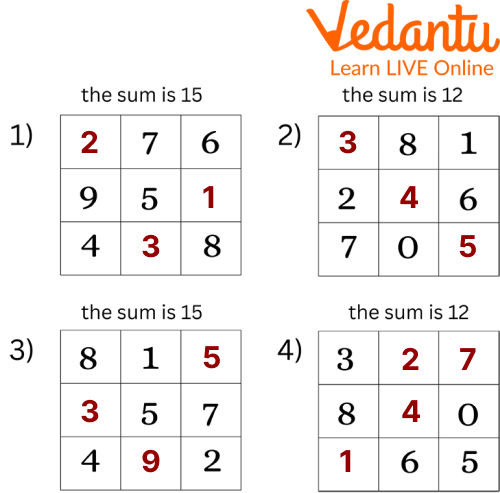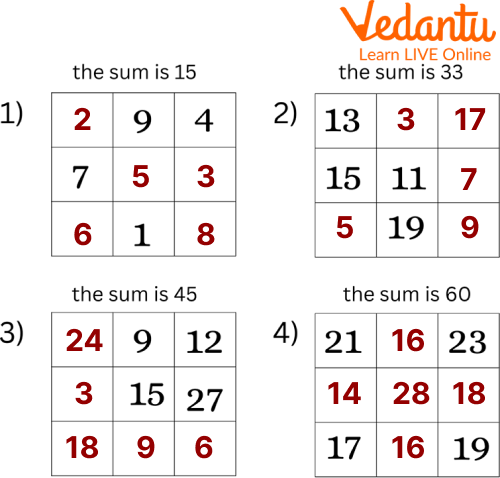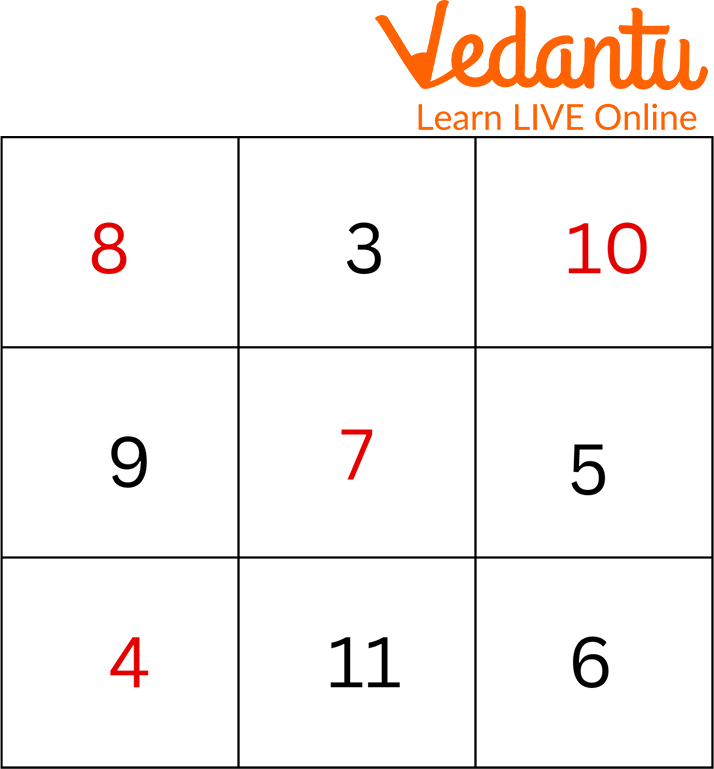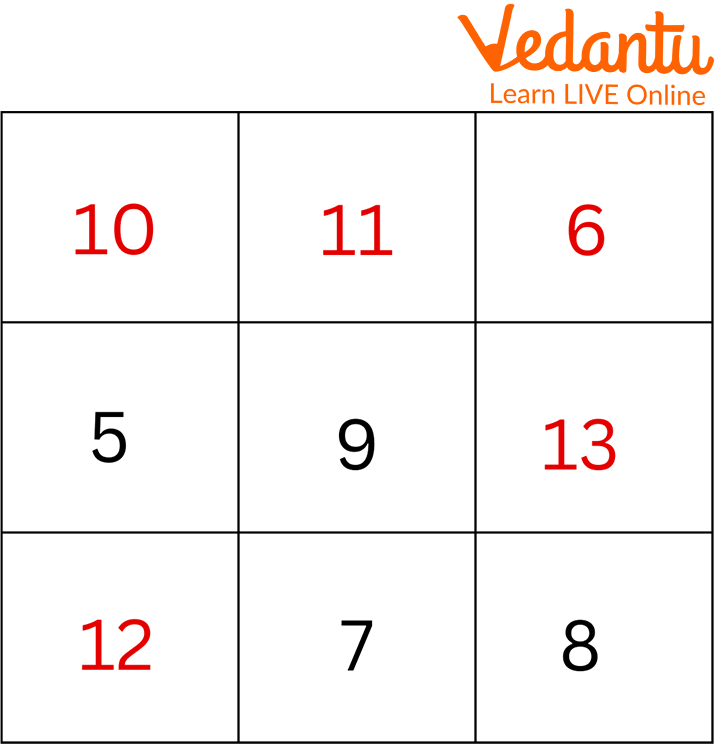




How Do Magic Squares Work? Definition, Examples & Uses
Magic Square is an interesting and very popular square that contains various different numbers arranged in such a way that the total sum of digits in each column, row and diagonal is the same.
And for this reason, this square puzzle is known as a magic square. Now you must be curious about how to make these magic squares and what is the formula of magic squares. So come let’s find the answers to all your questions in this article.
What is a Magic Square?
Magic squares are an excellent mathematical wonder for kids. It is a big square which is made up of the same number of rows with different numbers. And in this, each line of the square that may be horizontal/vertical or even diagonal makes up the same sum and this sum is known as the “magic number”.
For example, The magic square given below has numbers ranging from 1 to 9 and just look at how all the numbers in each column, row and diagonal add up to the magic number 15.

Magic Square
What is the Formula for Magic Squares?
The magic square puzzle of the order $\mathrm{n}$ is a group of “$n{ }^{2}$” digits in a big square. And the magic square consists of the numbers from 1 to $n 2$. And these numbers that are in the rows, columns and diagonals will add up to the same sum or the "magic number". And this magic number is denoted by the letter $\mathrm{M}$ whose value completely depends on the value of $n$.
So the formula to find the value of a magic number is:
$M=\dfrac{n\left(n^2+1\right)}{2}$
Tricks To Solve Magic Squares
As we got to know the formula for finding the magic number/sum is $\dfrac{n\left(n^2+1\right)}{2}$ so to find the magic square of order 3, the first step we'll substitute $n=3$ so that it'll be easy to form a magic square $3 \times 3$.
Now, $n=3$, the sum $=3(32+1)$
$\dfrac{3 \times 10}{2}=15 \text {. }$
So we will have to place the digits accordingly so that the numbers in all the rows, columns and diagonals will be equal to number 15.
Trick for Magic Square of Order 3
Let’s assume “x” as the order of our magic square.
Let's assume "$x$" as the order of our magic square.
So here, $x=3$
Let's consider the second number "$y$" so that the product of $x$ and $y$ will be equal to the magic number/sum, i.e., 15.
So, $y=5\{x y=(3)(5)=15\}$
Now put the value of $y$ at the centre of the magic square and $x$ on its left. And the cell above $x$ should be $y-1$ as you can see below:

Formula for Building Magic Square
Now according to this trick, magic squares of order 3 can be easily built.

Magic Square of Order 3
Magic Square 3 x 3
Let’s learn to make multiple magic squares of the same order by changing the numbers in different places from the magic square that we obtained above.
By taking the magic square $3 \times 3$ sum 15 that is shown below:

Magic Square 3 x 3
Let us make another magic square of the above square:
$\left(n^2+1\right)=32+1=9+1=10$
Next step is to subtract each number from $(n^2+1)$, that is 10 .
So first row numbers will be:
$10-4=6$
$10-3=7$
$10-8=2$
Second row numbers will be:
$10-9=1$
$10-5=5$
$10-1=9$
Third row numbers will be:
$10-2=8$
$10-7=3$
$10-6=4$
Finally the new magic square that is formed is will be:

The Newly Formed Magic Square
Magic Squares Worksheet
1. Worksheet 1: Magic Squares for Beginners

Magic Squares Worksheet for Beginners
Ans:

Magic Squares Worksheet for Beginners
2. Worksheet 2: Magic Square Puzzles:

Magic Square Puzzle Worksheet
Ans:

Magic Square Puzzle Worksheet
Practice Questions
Q 1. Fill the missing integrals in each of the magic squares and the magic number/sum is given.
The magic number is 21.

Practice Question 1
The magic number is 36.

Practice Question 2
The magic number is 27.

Practice Question 3
Answers.

Practice Question 1

Practice Question 2

Practice Question 3
Summary
In this article we got to know about the magic squares. These magic square puzzles are a great way to learn mathematics calculations in an easy way for kids. They also help in developing the addition and subtraction skills and strategies for solving the magic square questions and make it more engaging and interesting. And after solving the given worksheets and practice questions it will be easier for you to find the missing numbers in a magic square and even build a new magic square.
FAQs on Magic Squares Explained: Concepts, Tricks & Solutions
1. What is a magic square in Maths?
A magic square is a square grid filled with distinct numbers, where the sum of the numbers in each row, column, and main diagonal is the same. This constant sum is called the magic constant or magic sum. The most common type uses consecutive integers starting from 1. You can learn more about its definition and examples on the Magic Squares topic page.
2. How do you solve a 3x3 magic square?
Solving a 3x3 magic square using numbers 1 to 9 is a common mathematical puzzle. A simple trick to solve it is as follows:
- Start by placing the number '1' in the top-middle cell.
- Move one step up and one step to the right to place the next number ('2'). If you move outside the grid, imagine it wraps around to the opposite side.
- If a cell is already occupied, place the next number directly below the cell where the previous number was placed.
- Continue this pattern until all numbers from 1 to 9 are placed correctly.
3. Is there a formula to find the sum of a magic square?
Yes, there is a formula to calculate the magic constant (the sum) for a normal magic square of order 'n' (an n x n grid) that uses numbers from 1 to n². The formula is: M = n(n² + 1) / 2. For example, in a 3x3 magic square (where n=3), the magic sum is 3(3² + 1) / 2 = 15.
4. How can you check if a grid of numbers is a magic square?
To verify if a given grid of numbers is a magic square, you must perform a series of checks:
- Calculate the sum of the numbers in every single row.
- Calculate the sum of the numbers in every single column.
- Calculate the sum of the numbers along both main diagonals.
5. What is the real-life importance of learning about magic squares?
While not used in daily calculations, learning about magic squares is very important for developing foundational cognitive skills. They help improve:
- Logical Reasoning: You learn to think systematically and follow rules to reach a correct solution.
- Pattern Recognition: It strengthens your ability to see and understand patterns, a crucial skill in mathematics and other sciences.
- Problem-Solving: They act as engaging brain-teasers that enhance your approach to solving complex problems with fixed constraints.
6. Are there different types of magic squares?
Yes, magic squares are primarily categorised based on their 'order' (n), which is the number of rows or columns. The main types are:
- Odd-order squares: Where 'n' is an odd number (e.g., 3x3, 5x5).
- Singly-even squares: Where 'n' is divisible by 2 but not by 4 (e.g., 6x6, 10x10). These are more complex to construct.
- Doubly-even squares: Where 'n' is a multiple of 4 (e.g., 4x4, 8x8).
7. Can any set of numbers be used to create a magic square?
A 'normal' magic square specifically uses the set of consecutive integers from 1 to n² (for an n x n square). While it is technically possible to construct magic squares using other number sequences (like a series of prime numbers or specific even numbers), the classic definition and the standard formula for the magic constant are based on the sequence starting from 1.
8. Why is the sum of the diagonals the same as the rows and columns in a magic square?
This is not a coincidence but the essential feature that defines a magic square. The construction methods are mathematical algorithms precisely designed to distribute the numbers in a balanced arrangement. This systematic placement ensures that the sum is consistent not just horizontally (rows) and vertically (columns), but also across the two main diagonals, making the grid mathematically complete.















